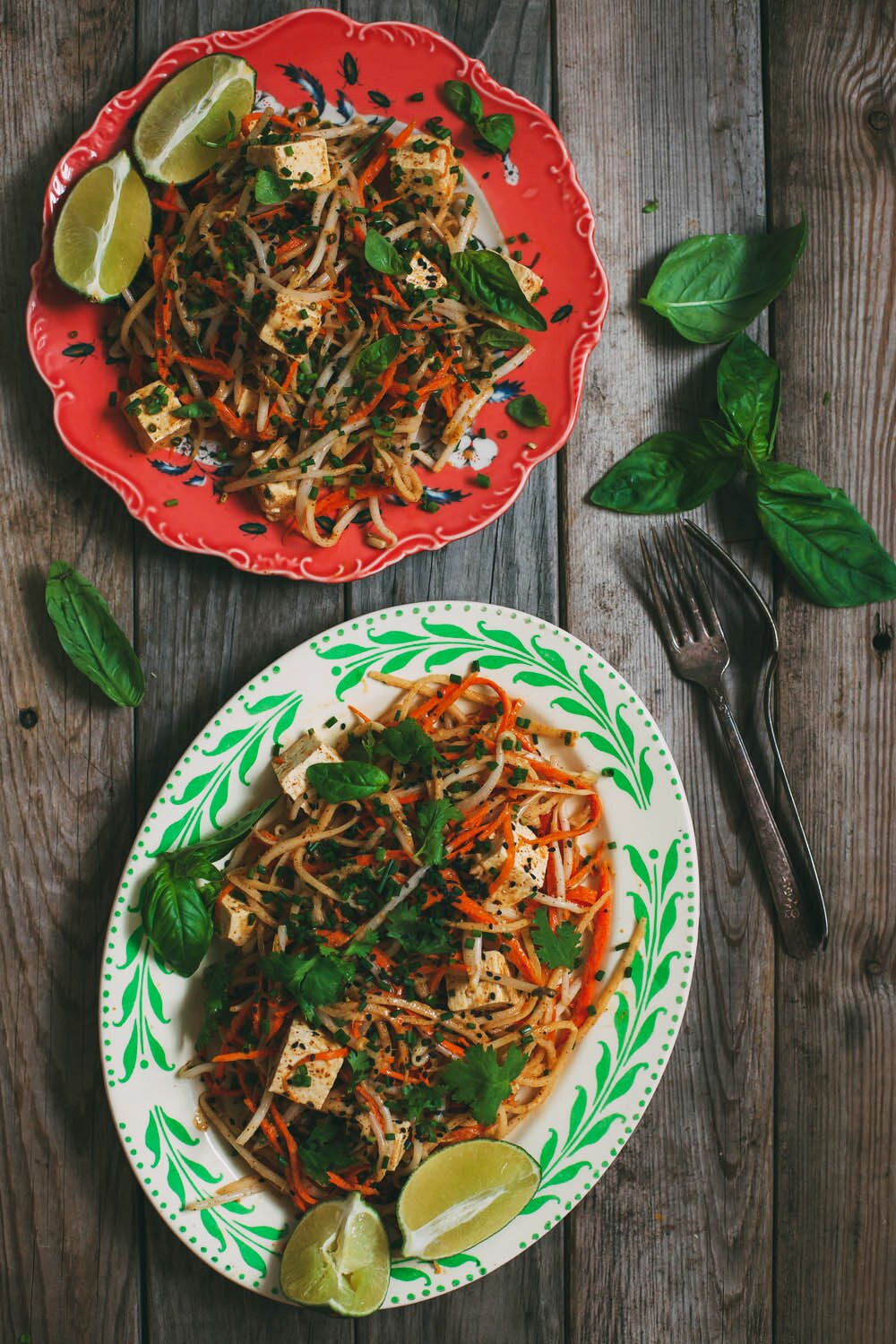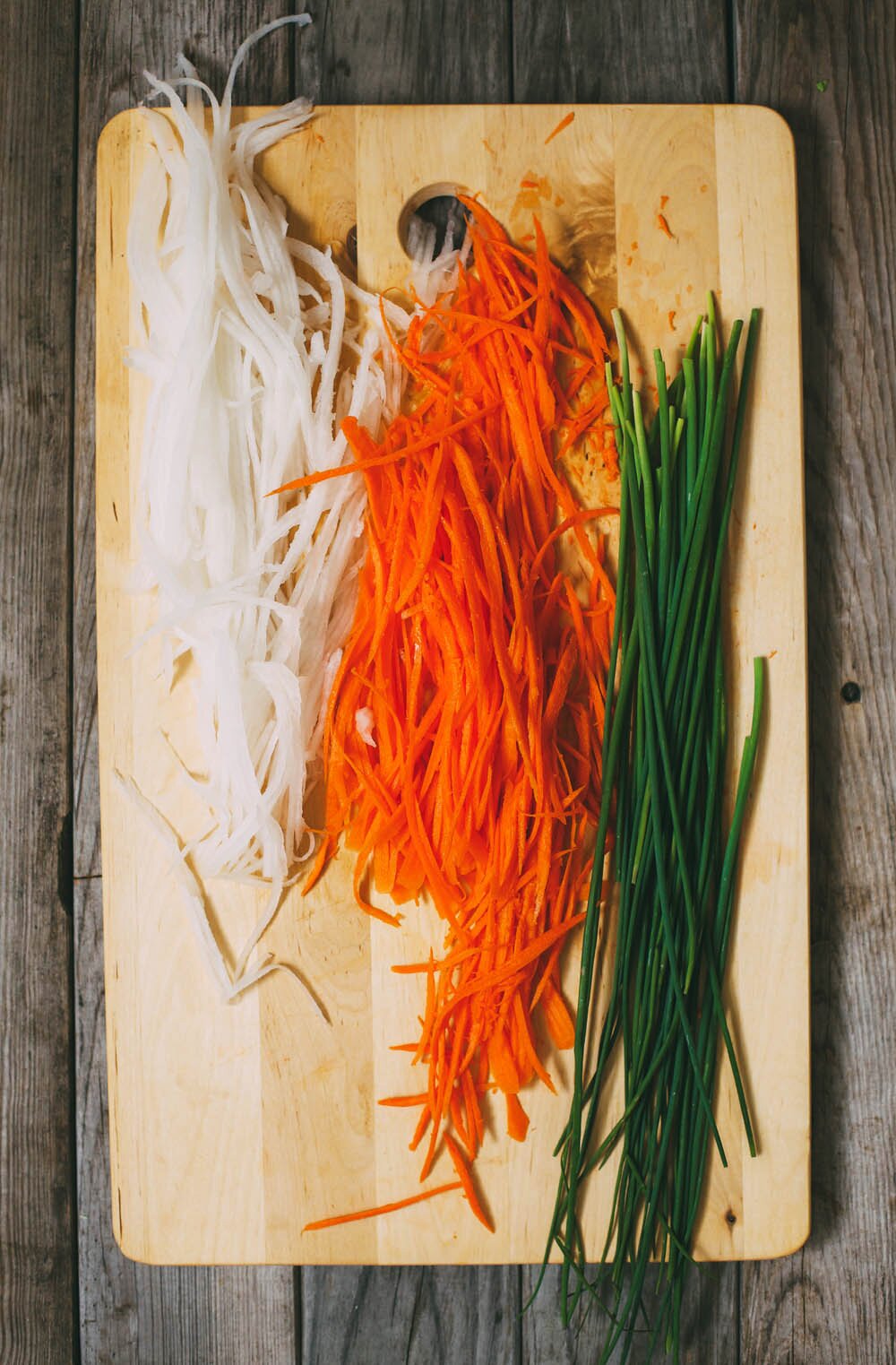
September 21st, 2014

I’m so excited to talk about the new creation of our long-time (virtual) friends, David and Luise, the team behind Green Kitchen Stories. I’ve been anticipating their second cookbook, Green Kitchen Travels, with much enthusiasm after admiring their work for many years. Once it arrived at my doorstep, I didn’t put it down until I saw the whole thing, studying every stunning image many times over. The book is filled with vibrant vegetarian and vegan dishes, many of which I was tempted to make right away. What makes it special is that every recipe is inspired by the authors’ travels around the world, often based on authentic dishes with a fresh, veggie-based twist. The creative and easy-going GKS style is evident on every page.

It was very tough for me to decide on a dish for this post. I was quite torn between the Crispy Aubergine Bites, Lentil and Strawberry Tacos, Sicilian Caponata, Vietnamese Pho, Vegan Moussaka, Indian Cardamom Laddu, Portuguese Sopa de Legumes and Lemongrass Brussels Sprout Curry. Finally, my never-ending love for Pad Thai took over, and this No Noodle Pad Thai recipe did not disappoint. The flavors here are warming, yet very fresh and crisp, with julienned daikon and carrots replacing noodles.
Now I’m off to shop for ingredients for the Caponata, before it’s too late in the season for tomatoes and eggplants.
The good news is that Green Kitchen Travels is available for pre-order right here! Thank you David and Luise for another beautiful cookbook.

No Noodle Pad Thai
1 daikon radish or zucchini
4 medium carrots – peeled
4 cups mung bean sprouts
4 spring onions (scallions) – finely chopped (I used chives here)
1 package firm tofu – cut in cubes
1 handfull cilantro leaves (I used basil because I had beautiful basil on hand)
2 tablespoons black or tan sesame seeds – toasted, plus extra for garnish
4 slices of lime – to serve
Sauce
1/2 cup (4 oz/125 g) peanut butter (I used almond butter)
4 tablespoons lime juice
2 tablespoons honey
2 tablespoons tamari or soy sauce
2 teaspoons grated fresh ginger
1 pinch ground cayenne pepper
1. Create the noodles from the daikon and carrots using a julienne peeler, mandoline, spiralizer or potato peeler. Place the ‘noodles’ into a bowl, then add in the mung bean sprouts, onions, tofu, herbs and sesame seeds. Mix well.
2. Stir together all the sauce ingredients in a separate bowl, add more water if needed. Adjust the seasoning.
3. Pour the sauce over the vegetables and toss to combine thoroughly, using your hands. Garnish with more herbs, sesame seeds and a slice of lime.
Note: If making ahead, store the salad and sauce refrigerated in two separate containers.
Tags: basil, carrots, daikon radish, pad thai, raw

March 25th, 2013
Today I’ve got a guest post for you that I am very excited about. When Karolina Eleonóra of The Raw Dessert Kitchen emailed me about a possible guest post on this amazing cake, I couldn’t wait to share such beauty. Let me introduce Karolina Eleonóra, a Swedish raw dessert chef with an eye for making really beautiful and decadent desserts. She specializes in nut-free desserts spiced with a variety of different super foods. For more of her delicious recipes, check out her eBook The Dessert Revolution. Here is what she says:
This cake is a tribute to the much-missed spring here in Sweden (it’s late this year). I’m trying to keep my spirit high by digging into a raw cake that pretty much has it all in terms of consistency, flavor, surprise effect and favorite ingredients, plus it was fun to make!
The base of the cake is a raw version of a bundt cake, moist from coconut oil and made with hazelnut flour. Inside hides a lemon cheesecake filling with crunchy cacao nibs and on top, melted dark chocolate. All together the cake managed to lift my mood and frozen body to a much higher state while eagerly waiting for spring.
Welcome Spring Cake
Hazelnut Sponge Cake Base
1 cup Hazelnut flour
7 Dates, smaller Helwah dates or 6 Medjool dates
1 tablespoon virgin Coconut oil
1 pinch of Himalayan salt
1/4 teaspoon real Vanilla from pod
1/4 teaspoon ground Cardamom
Pit and soak the dates for 5 minutes. In a food processor, add all of the ingredients and process until incorporated. Save some to create the bottom later (needs to be in the size of a peach).
Grease a 5 inch (13 cm) wide cup, bowl or miniature sponge cake pan with coconut oil and coat with some hazelnut flour. Press down the cake dough, making a round hole in the middle. Create a pretty finish using a spoon to “polish” the inside of the hole (where the filling goes later).
Lemon Cheesecake Filling
0.5 cups Cashews
0.5 cup Coconut milk (process 0.5 cup shredded Coconut with 2/3 cup Water in a blender and press the milk through a nut milk bag)
3 tablespoons virgin Coconut oil
1 pinch of Himalayan salt
1 tablespoon light Agave or Honey
Zest from one organic Lemon
1 teaspoon Lemon juice
One handful of Cacao nibs (is to be stirred in by hand in the end)
Grind the Cashews into a fine flour in a blender, put aside in a bowl. Make the Coconut milk in the blender, add the Cashew flour and the rest of the ingredients except the Cacao nibs. Process until completely smooth. Add the Cacao nibs, stir and pour the filling into the cake dough hole. Place in the freezer to be fully frozen. When fully frozen, create the bottom of the cake with the dough that you saved and press it down to cover the filling.
Place the whole cake up side down with a plate under and give it a couple of hours to thaw.
To remove the cup / bowl / pan, place a cloth soaked in hot water on top. If you have a metal bowl, gently tap it with the back of a knife.
Melted Chocolate
2 tablespoons virgin Coconut oil
2 tablespoons Agave
3-4 tablespoons raw Cacao powder
1 small pinch of Himalayan salt
1/8 of a teaspoon real Vanilla from pod
Melt the Coconut oil carefully in a water bath. Add the rest of the ingredients and stir with a whip. Wait for the chocolate to thicken a bit before you pour it over the cake. Decorate with more hazelnuts.
Tags: cake, cheesecake, chocolate, guest post, lemon, raw, recipe, vegan

September 8th, 2012
This post is also available in: French
Lately, there has been news of a number of blog to book projects that left us absolutely thrilled (La Tartine Gourmande, Cannelle et Vanille, GKS, Roost), and the Sprouted Kitchen cookbook is the latest release in that field. Being huge fans of Sara and Hugh Forte, we could hardly wait to receive our pre-ordered copy in the mail.
The book is full of Sara’s wholesome, approachable recipes beautifully illustrated by Hugh’s virtuoso photography. After devouring it cover to cover and being very inspired to get cooking, I decided to start with these quinoa collard green wraps complete with a carrot-miso spread, beets, sprouts, and avocado. My minor adjustment was sprouting the quinoa instead of cooking it, as suggested in the original recipe, but whichever method you prefer, the result is sure to be delicious. These wraps are full of clean, vibrant flavours, accompanied by a nice, healthy crunch. Next on my list are the Edamame Dumplings and Brussel Leaf Baby Spinach Saute, yum!
Check out the book for much more serious sprouted goodness.
Quinoa Collard Wraps
(makes 4 wraps)
8 large collard greens leaves – washed and dried
2 cups quinoa – sprouted or cooked
1 tablespoon sesame tahini
freshly squeezed lemon juice
1 cup roughly chopped carrots
1 tablespoon freshly grated ginger
1 small shallot – chopped
1 tablespoon of miso paste (I used unpasteurized chickpea miso from South River)
1 teaspoon honey
3 tablespoons brown rice vinegar
1 tablespoon sesame oil (decreased from the original 3 tablespoons)
1/4 teaspoon sea salt
2 cups of grated raw beets
1 avocado – peeled, pitted and sliced
1 cup sprouts or microgreens
Cut the end stems off each collard leaf and shave down the stalk, making it the same thickness as the rest of the leaf.
Mix tahini and a bit of lemon juice into the quinoa, set aside.
Combine carrots, ginger, shallot, miso paste, honey and vinegar in a food processor until smooth, adding sesame oil and salt at the end.
Using 2 leaves at a time, overlap them halfway to create a bigger wrapping surface. Place an even amount of carrot spread in each wrap. Top with quinoa, followed by beets, avocado and sprouts. Fold the collard sides over and roll tightly like a burrito. You can serve it immediately or store in the fridge, wrapped, for about 2 days.
Tags: beets, book review, carrots, collard greens, miso, quinoa, raw, recipe, salad, savoury, vegan, wraps





